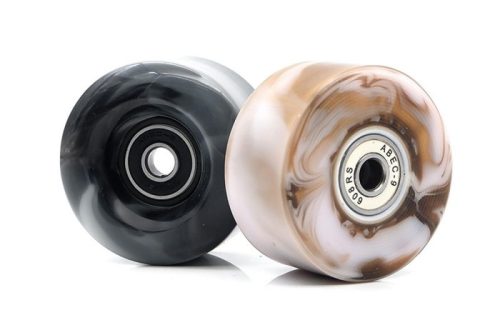Introduction to the Phantom Rubik’s Cube
The Phantom Rubik’s Cube presents a unique twist on the classic puzzle. Unlike its traditional counterpart, with distinct colors on each side, the Phantom Cube features sides that are all the same color when not lit. This adds a layer of complexity, since visual cues are limited.
At first glance, the Phantom Cube seems like an impossible puzzle. Its sides appear to be uniform, posing a challenge to even experienced cubers. But upon closer inspection, one can see subtle differences. The cube reveals its true form under specific lighting conditions, or through tactile clues to the solver.
Why choose a Phantom Rubik’s Cube? For many, it is a test of memory and skill beyond the regular cube. It also offers a fresh experience for those seeking a new challenge. The Phantom Cube tests cubers in ways they’re not used to – relying more on touch and spatial memory rather than sight.
For beginners, the Phantom Cube might seem daunting. However, it’s an opportunity to develop cognitive abilities like problem solving and logical thinking. As for seasoned solvers, mastering the Phantom Cube can be a rewarding accomplishment that pushes their limits.
In the upcoming sections, we will delve into the unique challenges that this cube presents. We will also explore strategies for conquering it, provide a step-by-step guide, and cover common mistakes to avoid. Advanced cubers can look forward to tips on speedcubing with the Phantom Cube. Finally, we’ll discuss the broader community and competitive scene surrounding this fascinating puzzle.

The Unique Challenges of Solving a Phantom Rubik’s Cube
Solving a Phantom Rubik’s Cube is unlike tackling the regular cube. First and foremost, the lack of color cues forces solvers to approach the puzzle differently. Since each side shows the same color when unlit, players cannot rely on their visual memory to find the solution. Instead, they must use touch and spatial memory skills to differentiate the pieces.
The second challenge arises from lighting conditions. The puzzle can only reveal its markings under certain lights, which means solvers have to either solve it under these specific conditions or memorize the locations beforehand.
Another hurdle is the increased demand on the solver’s memory. With a traditional cube, each color has a designated place, making it easier to remember algorithms and patterns. The Phantom Cube requires memorizing based on texture or other tactile cues, which is often more challenging for most people.
Lastly, for those used to speed solving, the Phantom Cube slows them down. Precision is key as a small misstep can set back the solver, given there are no colors to quickly reset positions by sight alone. It demands a slower, more deliberate method of handling.
Overcoming these challenges requires patience, practice, and a shift in solving strategies, which we will discuss in the following sections. The Phantom Rubik’s Cube offers a refreshing test for enthusiasts looking to push the boundaries of their problem-solving abilities.
Strategies for Mastering the Phantom Cube
Mastering the Phantom Rubik’s Cube is a journey that demands innovative strategies and dedicated practice. Here are several approaches to help cubers tackle this intriguing puzzle:
Familiarize with the Feel:
Begin by getting comfortable with the cube’s texture. Handling the cube frequently will sharpen your tactile perception, which is crucial for identifying different pieces without visual aids.
Develop a Keen Spatial Memory:
Practice visualizing the cube’s layout in your mind. Strengthening your spatial memory can compensate for the lack of color cues and help in memorizing piece locations.
Adjust Your Lighting:
Work under lighting conditions that best reveal the cube’s unique markings. Experiment with angles and intensities to find the optimal setup for solving.
Patience in Practice:
Patience is key. Rushing can lead to mistakes. Take your time with each move and aim for precision over speed.
Memory Techniques:
Utilize mnemonic devices to remember algorithms based on tactile cues instead of colors. This shifts the challenge from visual to mental, deepening your cognitive skills.
Incremental Learning:
Start by solving one layer at a time. Build familiarity with the Phantom Cube’s nuances in stages, rather than trying to conquer it all at once.
Use of Algorithms:
While traditional color-based algorithms might not hold, adapted or newly created algorithms for the Phantom Cube can be of great help. Dedicate time to learn and adjust these to serve your tactile solving approach.
Consistent Practice:
Consistency is essential. Regular practice cements the skills and strategies you’re developing, leading to gradual improvement and mastery.
Employing these strategies will set you on the right path towards mastering the Phantom Rubik’s Cube. With each solved puzzle, your problem-solving abilities will grow, making you a more adept solver not just for the Phantom Cube, but for other complex challenges as well.

Step-by-Step Guide to Solving the Phantom Cube
Solving the Phantom Rubik’s Cube needs clear, simple steps. Follow this guide to unlock the cube’s mystery:
- Start with the Edges: Feel for the edge pieces. Learn their shapes by touch.
- Move to the Corners: Identify corner pieces using tactile differences. Place them correctly.
- Form the Base Layer: Assemble the base layer. Use consistent turns and note piece arrangements.
- Work on the Middle Layer: Focus on the cube’s middle. Use spatial memory for placement.
- Complete the Top Layer: Match top pieces by shape, not color. Complete it last.
- Memorize Key Moves: Many algorithms from the color-based cube still apply. Remember their touch patterns.
- Practice Bridging Layers: Learn to transition between layers smoothly. Touch recognition helps here.
- Solidify Your Strategy: Once confident, refine your technique. Aim for fewer moves.
- Repeat and Improve: Practice makes perfect. Try many times. Learn from errors.
- Stay Patient and Positive: Tough at first, but improve with time. Keep a positive mindset.
Use these steps as your base. Adapt as you grow more skilled. The phantom rubik’s cube demands patience but rewards with sharpened mental skills and the thrill of mastery.
Common Mistakes and How to Avoid Them
Solving the phantom rubik’s cube can be tricky. Even the most skilled cubers can slip up at times. To improve, it’s crucial to recognize these common errors and learn how to dodge them. Here are a few common mistakes and tips on how to avoid them:
- Rushing through the solve: Without colors to guide you, haste can lead to mix-ups. Slow down. Make each move deliberate and precise.
- Neglecting tactile practice: It’s easy to rely on sight from past cube experience. Make sure to practice by touch to distinguish different pieces.
- Poor lighting conditions: Trying to solve the cube in weak lighting can hide tactile marks. Use bright, direct light to make them stand out.
- Inconsistent algorithms: Applying color-based algorithms can be less effective. Modify your methods to suit a tactile approach.
- Forgetting to visualize: Not using spatial memory can hinder your progress. Close your eyes. Try to picture the cube’s layout in your mind.
- Ignoring muscle memory: Muscle memory helps with fast, accurate moves. Repeat key patterns to build this skill.
- Lack of patience: Getting frustrated can ruin your focus. Stay calm, keep practicing, and the patterns will start to stick.
Remember that solving the phantom rubik’s cube is about learning a new way to solve an old puzzle. Take these tips to heart, and with practice, you’ll master the phantom cube in no time.
Advanced Techniques for Speedcubing Enthusiasts
For those looking to speedcube the Phantom Rubik’s Cube, mastering advanced techniques is key. Here are tips geared towards experienced cubers:
- Enhance Your Finger Tricks: Quick and precise finger movements help reduce solving time. Practice these to perform algorithms faster.
- Optimize Algorithms for Tactile Cues: Revise standard algorithms to fit tactile solving. This can save precious seconds.
- Improve Your Tactile Recognition: Train your fingers to identify pieces without hesitation. Faster recognition means quicker solves.
- Work on Look-Ahead: Try to plan your next moves in advance. This minimizes pause times during a solve.
- Balance Speed with Accuracy: Speed is useless if it leads to mistakes. Strive for a steady pace that maintains accuracy.
- Fine-Tune Your Setup: Adjust the cube’s tension to suit your style. This can help with smoother turns.
- Incorporate Blind Solving Techniques: These can help you memorize layouts faster, which is key for quick solves.
- Regularly Challenge Yourself: Time your solves and set goals. Beat your personal best to progress.
Implement these techniques carefully and consistently. Over time, you will see improvement in your speed and agility with the Phantom Rubik’s Cube.

The Role of Technology in Learning the Phantom Cube
Embracing technology can greatly aid in mastering the Phantom Rubik’s Cube. Here’s how tech can be a game changer:
- Use of Tactile Apps: There are apps designed to simulate the Phantom Cube experience. They can help learners understand the feel of the cube through a digital format.
- Online Tutorials and Videos: Numerous resources are available online to visually demonstrate solving techniques. These can offer guidance when physical practice isn’t possible.
- 3D Modeling Software: Cubers can use 3D programs to study the cube’s mechanics. It’s useful for visualizing the inner workings and planning moves.
- Virtual Reality (VR) Training: Advanced virtual setups can mimic the Phantom Cube solving. VR can enhance spatial understanding without the need for an actual cube.
- Forum Discussions: Engaging with others on online forums can offer support. Cubers share strategies, solve queries, and give feedback on different approaches.
- Algorithm Simulators: Certain software allows practice of algorithms. It’s a way to memorize patterns without using the cube.
- Smart Cubes: Some smart cubes provide data on your solves. They track progress and suggest areas of improvement.
Technology, if used wisely, can be instrumental in overcoming some of the Phantom Cube’s unique challenges. It connects learners to tools and communities that support and enhance the learning process.
Beyond Solving: Community and Competitive Aspects
The Phantom Rubik’s Cube has cultivated a passionate community and a competitive edge. Here’s how enthusiasts go beyond solving:
- Join Online Forums: Enthusiasts discuss strategies and showcase solves on forums. It’s a great way to connect and learn.
- Attend Meetups and Competitions: Local and international events bring cubers together. Compete, share tips, or simply enjoy the camaraderie.
- Follow Social Media Groups: Social platforms have active Phantom Cube groups. They offer news, challenges, and social engagement.
- Watch and Participate in Tournaments: Online and offline tournaments push the boundaries of speed and skill. Watch to learn, enter to test your abilities.
- Create or Join a Solving Club: Many schools and communities have solving clubs. These help sharpen skills and foster friendships.
- Share Your Progress: Documenting your journey can inspire others. Post videos or blogs and contribute to the shared knowledge base.
- Collaborate on Solving Methods: Work with others to develop new techniques. Collaboration can lead to breakthroughs in solving methods.
- Collect Different Cubes: Cube enthusiasts often collect various models. The Phantom Rubik’s Cube is a unique addition to any collection.
The Phantom Rubik’s Cube is more than a puzzle; it’s a gateway to a thriving world of collaboration, competition, and continuous learning.




